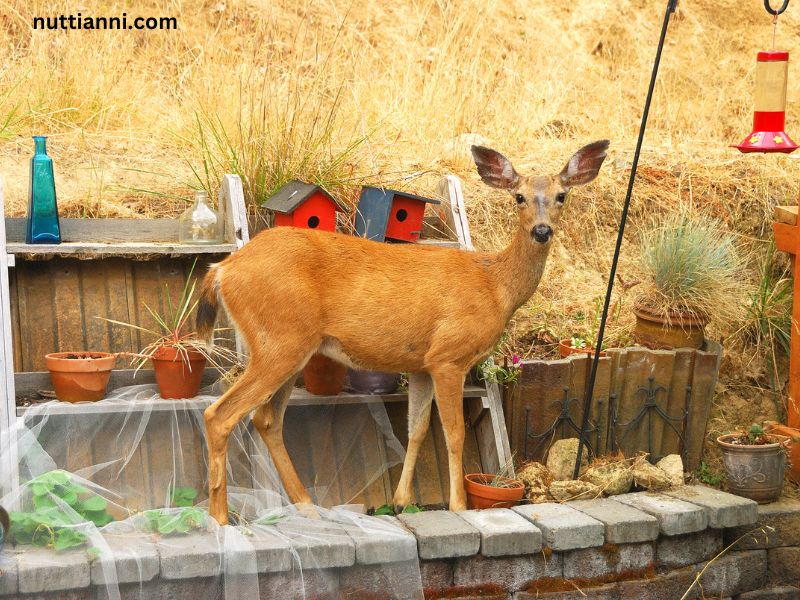Gardening can be a therapeutic and rewarding experience, but it often comes with its own set of challenges. One of the most common nuisances for gardeners, especially in rural or suburban areas, is deer. These graceful creatures, while beautiful to watch from a distance, can wreak havoc on your garden. They are known for munching on flowers, vegetables, and even trees, leaving gardeners frustrated and searching for solutions. Keeping deer out of your garden requires a multi-pronged approach, combining physical barriers, natural deterrents, and some clever tricks to make your garden less appealing to these four-legged invaders. In this article, we will explore various methods to keep deer at bay, ensuring that your garden thrives without interruption.
Understanding Deer Behavior: Why Do Deer Enter Gardens?
Before diving into the solutions, it’s essential to understand why deer are attracted to gardens in the first place. Deer are herbivores with a voracious appetite, and gardens often offer a smorgasbord of tasty plants that are easy to access. They are particularly fond of tender shoots, flowers, and fruits, and certain plants, such as hostas, tulips, and roses, are especially appealing to them.
In addition to food, deer may wander into gardens because of habitat encroachment. As human development expands into previously wild areas, deer find themselves in closer proximity to residential gardens. Once they discover a reliable food source, they are likely to return repeatedly unless deterred.
Physical Barriers: Fences and Netting
One of the most effective ways to keep deer out of your garden is to erect physical barriers. Deer are agile jumpers, so a simple fence may not be enough. However, with the right fencing, you can create an effective boundary that deer are less likely to cross.
1. Fencing
A tall, sturdy fence is the best long-term solution for keeping deer out of your garden. Deer can jump up to eight feet high, so a fence should be at least eight feet tall to be effective. If building a tall fence is not feasible, an alternative is to build a shorter fence with an angled top. Deer are hesitant to jump over fences that have a depth to them, so a slanted or double fence (two shorter fences placed several feet apart) can also work well.
Materials: Choose strong materials like wood, metal, or heavy-duty mesh. Avoid flimsy plastic or thin wire fencing that deer can easily push through.
Electric Fencing: For particularly persistent deer, electric fencing can be a powerful deterrent. When set up properly, it delivers a mild shock that will discourage deer from trying to breach the fence again.
2. Netting
If fencing is not an option, netting is another way to protect specific plants or sections of your garden. Netting can be draped over individual plants, flower beds, or small trees to make them less accessible to deer. This method is particularly useful for protecting vulnerable plants during the growing season.
Installation: Use stakes to secure the netting tightly to the ground, ensuring there are no gaps where deer can slip through. For larger areas, consider using deer netting or mesh that covers a broader section of the garden.
Downsides: While effective, netting can be cumbersome to install and may need to be removed or adjusted frequently, especially when accessing plants for maintenance or harvesting.
Planting Deer-Resistant Species
Another way to deter deer is by planting species that they find unappealing. Deer tend to avoid plants with strong scents, rough textures, or toxic properties. Incorporating these plants into your garden can help reduce the likelihood of deer making a meal of your flowers or vegetables.
1. Herbs and Aromatics
Many herbs have strong scents that deer dislike. Incorporating these into your garden can help repel deer while also providing you with culinary benefits.
Lavender: The strong fragrance of lavender is off-putting to deer. Plant it along the edges of your garden to create a natural barrier.
Rosemary: Another herb with a strong scent, rosemary can be used as both a border plant and a culinary herb.
Mint: While mint is known to spread quickly, its pungent smell can keep deer away. Consider planting mint in containers to prevent it from overtaking your garden.
2. Flowers and Ornamental Plants
Certain flowers and ornamental plants are less appealing to deer due to their texture or taste.
Daffodils: These bright flowers are toxic to deer and other animals, making them an excellent choice for a deer-resistant garden.
Foxglove: Another toxic plant, foxglove’s tall spikes of flowers are beautiful but deadly to deer.
Ferns: The rough texture of ferns is unappealing to deer, making them a good choice for shaded areas of the garden.
3. Vegetables
While most vegetables are a favorite food for deer, there are a few that they tend to avoid.
Garlic and Onions: Deer dislike the strong smell and taste of garlic and onions, making these plants a good option for garden borders.
Hot Peppers: Spicy plants like hot peppers are typically avoided by deer due to their heat.
Natural Deer Repellents
If you prefer a less invasive approach, natural deer repellents can be a great way to deter deer without harming them or the environment. These repellents work by either creating unpleasant smells or tastes that deer avoid.
1. Homemade Repellents
You can create your own deer repellents using common household ingredients.
Egg Spray: Deer dislike the smell of eggs, so an egg-based spray can be effective in keeping them away. To make it, mix one egg with a quart of water and spray it on plants.
Soap: Hanging bars of soap around the perimeter of your garden can help deter deer. The strong scent of soap is unpleasant to them, especially soaps with a strong fragrance like Irish Spring.
Garlic Spray: A garlic-based spray can be made by blending garlic cloves with water. Spray it on plants to create a barrier that deer are unlikely to cross.
2. Commercial Repellents
If DIY methods aren’t your style, there are many commercial deer repellents available. These products often contain ingredients like putrescent egg solids, garlic, and capsaicin, which make plants taste and smell unappealing to deer.
Granular Repellents: These are sprinkled around the garden and work by emitting a scent that deer avoid. Some products also include predator urine, which triggers a natural fear response in deer.
Spray Repellents: Similar to homemade sprays, these are applied directly to plants and need to be reapplied after rain.
Motion-Activated Deterrents
Deer are naturally skittish animals, and they tend to avoid areas where they feel threatened. Motion-activated devices can exploit this behavior by startling deer when they approach your garden.
1. Motion-Activated Sprinklers
These devices detect movement and release a burst of water when triggered. The sudden spray of water startles deer and encourages them to leave the area. Over time, deer may learn to avoid your garden entirely.
Placement: Set up the sprinklers along common entry points to your garden or near plants that are particularly vulnerable to deer.
Maintenance: These devices require access to water and regular battery changes, but they are generally low-maintenance and effective.
2. Motion-Activated Lights
Flashing lights can also startle deer, especially at night. Motion-activated lights can be installed around the perimeter of your garden to create an environment that feels unsafe for deer.
Companion Planting and Garden Layout
The way you design your garden can also help deter deer. By strategically placing certain plants and using companion planting techniques, you can make your garden less appealing to these animals.
Barrier Plants: Use deer-resistant plants like lavender, rosemary, or ferns to create a natural barrier around more vulnerable plants.
Plant in Clusters: Deer are more likely to avoid densely planted areas where it’s harder to move around and access individual plants.
Conclusion
Keeping deer out of your garden requires a combination of strategies. By understanding deer behavior, utilizing physical barriers, planting deer-resistant species, and employing natural repellents, you can protect your garden from these graceful but destructive creatures. With persistence and creativity, you can maintain a thriving garden that remains a deer-free zone.









